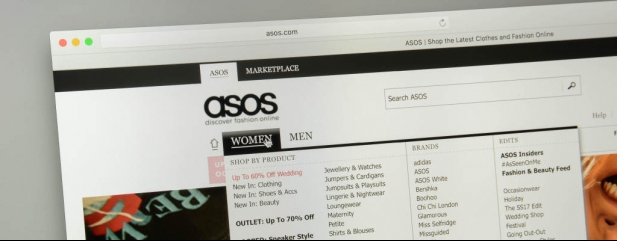Archived article
Please note that tax, investment, pension and ISA rules can change and the information and any views contained in this article may now be inaccurate.
There is so much to like about ASOS as an investment

Investors seeking exposure to a global growth stock with a powerful structural tailwind at its heels should bag shares in high-flying online fashion retailer ASOS (ASC:AIM).
Though the stock has already powered ahead during the pandemic, ASOS is in an upgrades cycle driven by the accelerated spending shift to the web.
It trades on roughly 35 times forward earnings estimates for the next two years, a punchy yet palatable rating considering the international growth opportunity ahead.
Covid-19 has dramatically accelerated the shift towards online shopping and a vaccine-induced return to socialising around the world should turbo-charge growth rates at ASOS, which is also benefiting from investments in warehouse efficiency.
TOP (ONLINE) SHOP
While the pandemic has put socialising on hold, reducing demand for occasion and formal wear, agile operator ASOS has pivoted towards categories including activewear and lockdown relevant products.
The retail giant has clearly benefited from the closure of rivals’ non-essential brick and mortar stores during lockdowns and virus-related restrictions, which have enabled it to grab market share and generate
good growth in active customer numbers.
Boohoo (BOO:AIM), ASOS’ online fast fashion rival, may have bagged the online business and brand assets of collapsed department store Debenhams, but ASOS is also seeking to cherry-pick prized assets from another fallen retailer, Arcadia.
As Shares went to press, the online retailer for fashion-loving 20-somethings was in exclusive talks with the administrators over the acquisition of Arcadia’s Topshop, Topman, Miss Selfridge and athleisure brands.
ASOS believes this potential deal would represent ‘a compelling opportunity to acquire strong brands that resonate well’ with its customer base and would be funded from the group’s considerable cash reserves.
Shares believes these brands would be exciting additions to ASOS’ online platform, through which it sells unique in-house labels as well as an array of winning third party brands.
Chief executive Nick Beighton clearly believes that the Topshop, Topman, Miss Selfridge and athleisure brands still resonate sufficiently with value and fashion conscious shoppers, even if their heyday may have passed.
ASOS would by far be the most complementary new owner for Topshop, Topman and Miss Selfridge, brands which are already popular sellers through its third-party platform, while its global reach and digital prowess should help these brands to attract new shoppers.
STILL STRUTTING ITS STUFF
Even if the deal fails to materialise, ASOS is still a very strong business delivering double digit revenue growth across major geographies and with years of profitable expansion opportunity ahead of it.
At a time when many shopkeepers are laying off staff or even going under, ASOS is in rude health, having just announced it will invest £90 million in a new warehouse in Staffordshire to support growth, with a plan to employ 2,000 people at the site over the next three years.
The international business is growing like topsy as ASOS leverages its global infrastructure including warehouses in the UK, US and Germany. ASOS grew revenues in the EU and Rest of World regions in the four months to December 2020 while seeing increasing momentum in the important US market.
And the ASOS brand continues to resonate on home turf too. UK sales shot up by 36% to £554 million in its first quarter, triggering another earnings upgrade from ASOS, whose performance also reflected the resumption of lower product return rates driven by tighter social restrictions.
Following the trading update, Numis upgraded its pre-tax
profit forecast for the year to August 2021 from £135 million to £170 million and its 2022 estimate from £175 million to £180 million.
RISKS TO CONSIDER
Poor environmental, social and governance practices have dogged its rival, Boohoo. However, ASOS’s reputation remains intact and investors aren’t treating it with the same scepticism even though it operates in the same fast fashion space.
Boohoo is known for selling cheap dresses that are worn once and chucked, which isn’t environmentally friendly. ASOS’s core proposition is much broader, with customers using it for coats, trainers, jeans, jumpers as well as dresses and tops.
In the short term, the financial hardships and lifestyle disruptions that Covid is inflicting on ASOS’s core shopper demographic is a key risk to consider.
Yet on the flipside, young fashionistas with robust finances and job security are kicking their heels during lockdown and looking for things to spend their money on, which should support sales growth rates near term.
Put bluntly, a good chunk of its target market is bored at home and ordering clothes and shoes gives them something to look forward to.
This tailwind is likely to ease as society starts to reopen, however at that point you’ll see people wanting to refresh their wardrobes again as they rediscover their social life. There is plenty to like about ASOS
on both a short and long-term basis.
Important information:
These articles are provided by Shares magazine which is published by AJ Bell Media, a part of AJ Bell. Shares is not written by AJ Bell.
Shares is provided for your general information and use and is not a personal recommendation to invest. It is not intended to be relied upon by you in making or not making any investment decisions. The investments referred to in these articles will not be suitable for all investors. If in doubt please seek appropriate independent financial advice.
Investors acting on the information in these articles do so at their own risk and AJ Bell Media and its staff do not accept liability for losses suffered by investors as a result of their investment decisions.
Issue contents
Editor's View
Feature
First-time Investor
Great Ideas
- Act fast with Brunner to secure very cheap access to good stocks
- Stick with Yamana Gold despite falling share price
- Don't be tempted to take profit on Treatt following recent share price spike
- Good strategic process is helping to drive up shares in PZ Cussons
- Ford shares electrified and there could be more to come
- There is so much to like about ASOS as an investment
Investment Trusts
Money Matters
News
- Surge in amateur day traders suggests final stages of market bubble
- Terry Smith denies overexposure to highly valued tech firms
- Market excitement is building over electric vehicle growth
- Rolls-Royce under pressure after new setback
- Asian stock markets have raced ahead so far in 2021
- Companies may tap investors again for cash to survive the crisis

 magazine
magazine











